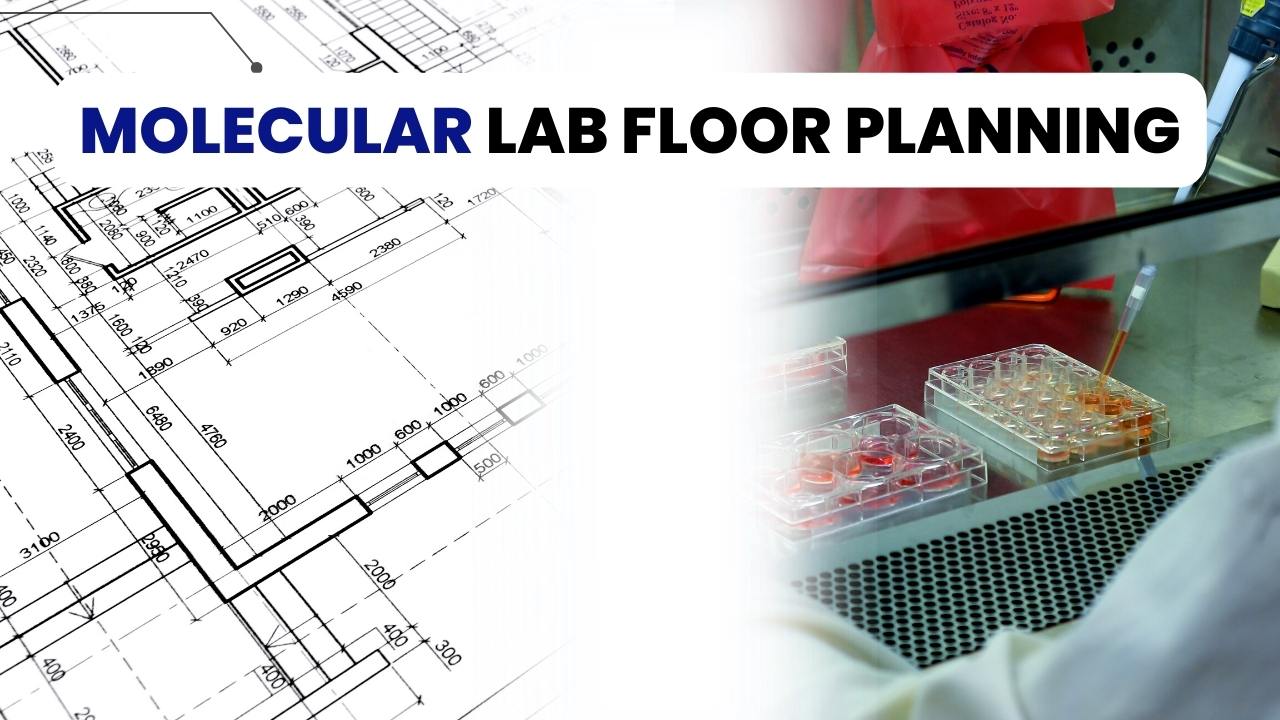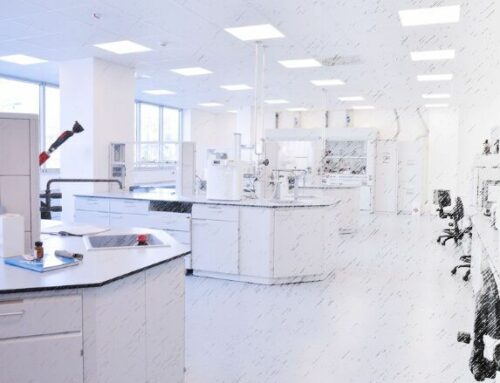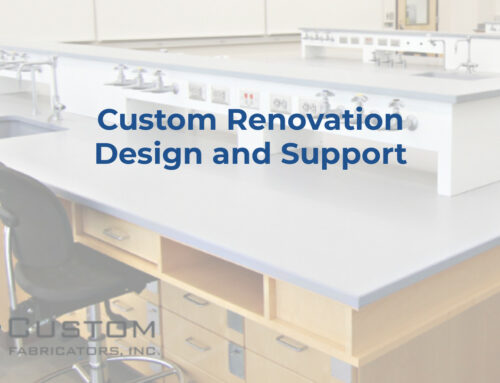Effective Floor Plans for Molecular Laboratories
Rapid identification of infectious, disease-causing pathogens is paramount to treating at-risk individuals and limiting transmission. A molecular testing laboratory supports the analysis of human genes to understand disease, its development, and the most effective treatment methods.
The techniques used include polymerase chain reaction (PCR) of either DNA (PCR) or RNA (RT-PCR), isothermal amplification, and sequencing. These techniques, especially the PCR-based methods, are powerful enough to detect a single molecule of DNA.
While high sensitivity is their greatest strength, it is also their greatest weakness. It makes them vulnerable to cross contamination, particularly from external DNA sources.
Contamination can lead to erroneous results and a loss of credibility for the lab. Also, the cleanup process and efforts to identify the source of contamination can lead to lab downtime and delays, which have negative financial and performance impacts. Good laboratory design is the most effective way to make contamination a rare event. Hence, special considerations, such as providing adequate space, appropriate equipment, and qualified personnel, must be made. Other considerations include:
- mechanical barriers to prevent contamination
- the spatial separation of pre- and post-amplification work areas
- equipment and appliances
- unidirectional workflow
- ventilation and air pressure requirements.
Molecular laboratory floor plans and design requirements
The fundamental considerations when designing a lab layout include the lab’s function, its workflows and processes, critical requirements such as equipment and utilities, and future lab growth goals.
Good designs keep users safe and maximize efficiency to increase productivity and profitability. They also ignite creativity and have the flexibility to adapt to a quickly changing business environment.
Potential sources of contamination include:
- Cross contamination between specimens.
- Amplification product contamination: Repeat amplifications of the same target sequence in PCR techniques lead to the accumulation of amplification products in the lab. A typical PCR generates about 109 copies of the target sequence. Aerosols from pipettes may contain as many as 106 amplification products. Hence, the buildup of aerosolized amplification products may contaminate lab reagents, equipment, and ventilation systems.
- The work environment, including laboratory work surfaces.
- Laboratory technicians’ work habits: Without the appropriate protective gear, lab users can transfer amplification products from contaminated rooms to clean rooms via their hair, skin, saliva, or clothing. The main ways to control contamination can be achieved through a good lab floor plan and design. A layout physically separating lab areas for sample preparation, reagent preparation, amplification, and post-amplification analysis is ideal. Cross contamination can also be controlled by minimizing sample manipulation, putting in place positive controls, and following good laboratory practices.
The main ways to control contamination can be achieved through a good lab floor plan and design.
A layout physically separating lab areas for sample preparation, reagent preparation, amplification, and post-amplification analysis is ideal.
Cross contamination can also be controlled by minimizing sample manipulation, putting in place positive controls, and following good laboratory practices.
Mechanical barriers to prevent contamination
Some mechanical barriers that help prevent the carryover of amplification products include:
- Ensuring the strict separation of sample and reagent preparation areas from the amplification and post-amplification areas.
- Facilitating unidirectional workflow traffic from the reagent preparation area to the sample preparation area to the amplification area and finally to the detection area.
- Equipping each area with the necessary instruments, disposable devices, laboratory coats, gloves, aerosol-free pipettes, and ventilation systems.
- Practicing good laboratory habits, such as always wearing protective gear.
- Practicing good laboratory habits, such as always wearing protective gear and using color-coded lab coats for different spatially separated areas.
The spatial separation of pre- and post-amplification work areas

Ideal layout for molecular laboratory
An efficient design to prevent contamination allows for the use of separate areas or rooms for pre-amplification, amplification, and post-amplification stages, with different ventilation systems for each area.
Ideally, a molecular testing laboratory should have three or four separate rooms, depending on the techniques used. At a minimum, it is recommended to have two rooms — a pre-PCR or clean room for sample and reagent preparation, a post-PCR or dirty room for PCR amplification and analysis.
Features of the three areas
Area 1: Reagent preparation. This area is usually one of the cleanest areas in a molecular testing laboratory because it is typically free of biological material, such as DNA/RNA. To reduce the possibility of contamination, extracted DNA/RNA or PCR products should never be present in the reagent preparation room. This area is dedicated to the preparation and aliquoting of reagent stock. Preparation of reaction mixes may also be done here.
Equipment found in this room includes pipettes, vortex mixers, spin-down centrifuges, a refrigerator, a freezer, and laminar hoods.
Area 2: Sample preparation. This area may comprise two rooms, one for nucleic acid extraction and the other for nucleic acid addition to PCR reaction mixes. If there is insufficient space for two rooms, the two steps can be done in the same room but in different areas or compartments.
Lab workers should conduct PCR reactions in biosafety cabinets to protect the user, the product, and the environment from hazardous materials.
Standard equipment for the sample preparation rooms includes high-speed centrifuges, vortex mixers, pipettes, autoclaves, and refrigerators.
Area 3: Amplification and post-amplification analysis. These two comprise the contaminated (dirty) rooms. Therefore, no equipment or material used in these rooms can be transferred to or used in other rooms. This space is where amplification steps occur, using instruments such as a thermocycler.
A laminar flow hood is recommended for any steps requiring the opening of tubes containing amplicons. To control contamination further, it is also critical that laboratory technicians performing post-PCR analysis do not return to pre-PCR work areas on the same day.
Any standard equipment?
Alternatives to spatial separation
If there is insufficient lab space for dedicated rooms, separate work tables and benches should be identified for pre- and post-PCR activities. Biosafety cabinets also offer a safe way to separate the processes.
Scheduling pre- and post-PCR procedures at different times of the day is an additional control that can be implemented if all the processes must be performed in the same room.
Molecular lab equipment and appliances
Every area or room in a molecular testing laboratory should have equipment appropriate to the work carried out and the techniques used in that space. Standard appliances and equipment in molecular labs include the following.
| Equipment | Purpose of use |
|---|---|
| Refrigerator | For storage of chemicals and PCR products at an average temperature of +40C. |
| Freezer | For storage of frozen tissue cultures and samples at temperatures ranging between -200C and -800C. |
| Vortex mixer | For mixing small vials quickly in an oscillating circular motion and for the resuspension of cells. Vortex mixers are available with variable speeds and the option for continuous function or on-demand function. |
| Centrifuge | To separate fluids, gases, or liquids based on density. There are various types of centrifuge, which are classified by either the intended use or the rotor design. |
| Thermal cycler | To amplify DNA and RNA samples by PCR. It is also used for DNA sequencing, cloning, generation of probes, quantification of DNA and RNA, studying patterns of gene expression, detection of sequence-tagged sites, and many more techniques. |
| Spectrophotometer | To measure light absorption in a sample, which can be used to determine nucleic acid quantitation or the number of chemicals in a solution. |
| DNA sequencer | For the observation of DNA’s molecular sequence. |
| Microscope | For the observation and evaluation of samples. |
| Autoclave | To sterilize waste and lab equipment. |
| Laminar flow and biosafety cabinets | To prevent contamination. |
| Electrophoresis system | For conducting PCR analysis. |
| Incubator | To maintain optimal conditions, such as temperature and humidity. |
| pH meter | For measuring hydrogen-ion activity in water-based solutions. |
| Water bath | For incubating samples at a constant temperature. |
| Gel imaging system | For analysis of proteins, nucleic acid, and antibodies. |
Unidirectional workflow
The laboratory floor plan should be designed to increase work efficiency. It must also be unidirectional (i.e., continue in one direction only) from the clean area to the dirty area. Whenever researchers or laboratory technicians move from one room to another, lab coats, gloves, and other protective equipment must be changed, and hands must be washed to prevent contamination.
Ventilation and air pressure requirements
Air circulation between pre and post-amplification areas can be a source of contamination in labs. So, each room should be ventilated separately and air pressure adjusted independently.
Positive air pressure means that the air pressure inside the room is higher than the one outside the room, which prevents the transport of unwanted substances from outside. Negative air pressure allows air to enter the room and prevents air migration to the surrounding rooms. In these rooms, doors must be kept closed to maintain the negative pressure.
The pre-PCR rooms should have a slight positive pressure to prevent the entrance of contaminated air from outside. In contrast, the post-PCR rooms should have a slight negative pressure to keep the air in and prevent the escape of amplicons from the completed PCR samples.
The ventilation of pre-PCR and post-PCR spaces should be open to different air channels and should pull air from separate locations.
Other requirements
- Provide an office area that is separate from the laboratory rooms. It should have adequate office furniture where staff can take breaks with access to safe drinking water.
- Provide locked storage spaces for clothing, personal items, and protective equipment.
- Consider temperature and humidity requirements, ergonomic assessments, electric outlets, backup power systems, and other relevant utilities.
How can CFI help?
When designing something as specific and sensitive as a molecular testing lab, you need to enlist the help of experts. With over 60 years of experience in lab design and furnishing, we know which critical questions need answers when building a molecular testing laboratory. We will work with you to identify your needs, design a lab that optimizes your space, and provide all the needed equipment and appliances.






